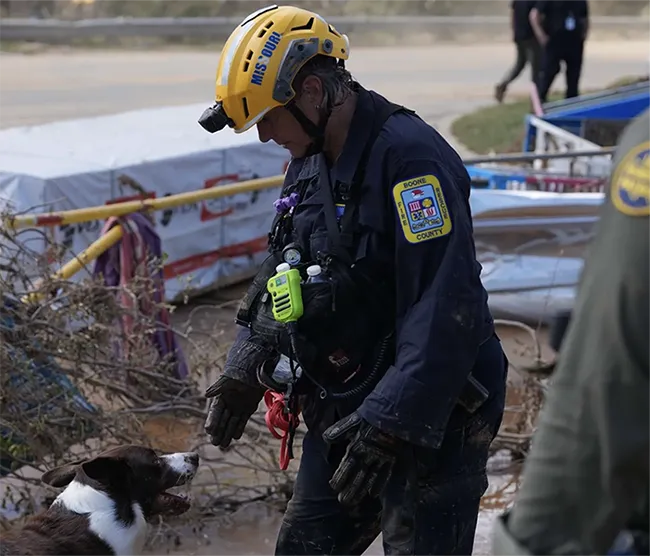November 19, 2024
Cadaver dogs and their handlers comb through piles of debris to find people lost during Hurricane Helene

Cadaver dog handlers are always looking for ways to keep their dogs interested during a long search. (FEMA photo via NC Health News)
Hurricane Helene's torrential rains and flooding across western North Carolina didn't just decimate homes and businesses, it swept people away, leaving many communities still searching through rubble for lost loved ones. To help find the missing, cadaver dogs and their handlers are painstakingly working through debris and high waters.
"Highly trained dogs have played a crucial role in finding victims’ remains; one canine-assisted search team from Guilford County recovered 20 bodies in the immediate aftermath of the storm," reports Jaymie Baxley of NC Health News. "These specialist canines and their handlers are likely to find more casualties in the weeks to come, according to cadaver dog expert Cat Warren." Baxley spoke with Warren about the added challenges cadaver dogs and handlers face after natural disasters. Their edited Q&A is below.
Baxley: What are some of the unique challenges involved in training a dog to detect human remains — especially in disaster scenarios like hurricanes?
Cat Warren: Disaster work adds bunches of challenges on top of just finding the scent of human remains. It takes absolute experience for the dogs and handlers to work in these situations.. . . In a tragedy like this, you also have so much competing odor. . . . Many times, the dogs will work for hours and hours without finding anything.
Baxley: How do factors like flooding, mudslides or dense forests affect the ability of dogs to detect remains after events like hurricanes?
Cat Warren: But in these cases, the dog may not be able to get close enough or the scent is so fractured that the dog is somewhat uncertain. That’s when the handler is going to tell people who are flanking them, 'Look, the dog showed real interest here.' The dog may not give his final indication because that body or that scent is underneath a pile of debris, so it’s then up to the searchers to go in and search that pile of debris.
Baxley: How would you describe a typical search operation involving cadaver dogs in disaster-hit areas? Is there a timeline for the work?
Cat Warren: It’s grim, but the timeline for this is going to be months because there’s such a huge area to search.. . . Officials are still gathering accounts of where people went missing, and we have a homeless population in Asheville that is probably very much still unaccounted for.
Baxley: What improvements or advancements have you seen in cadaver dog training that could enhance future search and recovery efforts?
Cat Warren: Generally, training over the past 20 years or so has improved at the highest levels because people have a greater understanding of how positive reinforcement and motivation can be used to train dogs in a really disciplined way. . . . One of the things that handlers are doing all the time is figuring out how to keep these dogs motivated over long search periods.
For handlers, some of the feelings may come afterward. These guys are doing really, really hard work. It is exhausting, and it takes a real physical and emotional toll. . . .